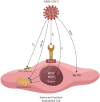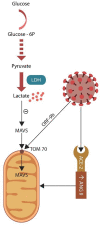PTSD as an Endothelial Disease: Insights From COVID-19
- PMID: 34776871
- PMCID: PMC8586713
- DOI: 10.3389/fncel.2021.770387
PTSD as an Endothelial Disease: Insights From COVID-19
Abstract
SARS-CoV-2 virus, the etiologic agent of COVID-19, has affected almost every aspect of human life, precipitating stress-related pathology in vulnerable individuals. As the prevalence rate of posttraumatic stress disorder in pandemic survivors exceeds that of the general and special populations, the virus may predispose to this disorder by directly interfering with the stress-processing pathways. The SARS-CoV-2 interactome has identified several antigens that may disrupt the blood-brain-barrier by inducing premature senescence in many cell types, including the cerebral endothelial cells. This enables the stress molecules, including angiotensin II, endothelin-1 and plasminogen activator inhibitor 1, to aberrantly activate the amygdala, hippocampus, and medial prefrontal cortex, increasing the vulnerability to stress related disorders. This is supported by observing the beneficial effects of angiotensin receptor blockers and angiotensin converting enzyme inhibitors in both posttraumatic stress disorder and SARS-CoV-2 critical illness. In this narrative review, we take a closer look at the virus-host dialog and its impact on the renin-angiotensin system, mitochondrial fitness, and brain-derived neurotrophic factor. We discuss the role of furin cleaving site, the fibrinolytic system, and Sigma-1 receptor in the pathogenesis of psychological trauma. In other words, learning from the virus, clarify the molecular underpinnings of stress related disorders, and design better therapies for these conditions. In this context, we emphasize new potential treatments, including furin and bromodomains inhibitors.
Keywords: COVID-19; PTSD; SARS-CoV-2; endothelia; lactate; mitochondria.
Copyright © 2021 Sfera, Osorio, Rahman, Zapata-Martín del Campo, Maldonado, Jafri, Cummings, Maurer and Kozlakidis.
Conflict of interest statement
The authors declare that the research was conducted in the absence of any commercial or financial relationships that could be construed as a potential conflict of interest.
Figures




Similar articles
-
Endothelial dysfunction and COVID-19 (Review).Biomed Rep. 2021 Dec;15(6):102. doi: 10.3892/br.2021.1478. Epub 2021 Oct 7. Biomed Rep. 2021. PMID: 34667599 Free PMC article. Review.
-
Hypoxia modifies levels of the SARS-CoV-2 cell entry proteins, angiotensin-converting enzyme 2, and furin in fetal human brain endothelial cells.Am J Obstet Gynecol MFM. 2023 Oct;5(10):101126. doi: 10.1016/j.ajogmf.2023.101126. Epub 2023 Aug 8. Am J Obstet Gynecol MFM. 2023. PMID: 37562534
-
Insights on SARS-CoV-2 Molecular Interactions With the Renin-Angiotensin System.Front Cell Dev Biol. 2020 Sep 16;8:559841. doi: 10.3389/fcell.2020.559841. eCollection 2020. Front Cell Dev Biol. 2020. PMID: 33042994 Free PMC article. Review.
-
SARS-CoV-2 pandemic and research gaps: Understanding SARS-CoV-2 interaction with the ACE2 receptor and implications for therapy.Theranostics. 2020 Jun 12;10(16):7448-7464. doi: 10.7150/thno.48076. eCollection 2020. Theranostics. 2020. PMID: 32642005 Free PMC article. Review.
-
Cognitive impact of COVID-19: looking beyond the short term.Alzheimers Res Ther. 2020 Dec 30;12(1):170. doi: 10.1186/s13195-020-00744-w. Alzheimers Res Ther. 2020. PMID: 33380345 Free PMC article. Review.
Cited by
-
Quality of Life in COVID-Related ARDS Patients One Year after Intensive Care Discharge (Odissea Study): A Multicenter Observational Study.J Clin Med. 2023 Jan 29;12(3):1058. doi: 10.3390/jcm12031058. J Clin Med. 2023. PMID: 36769705 Free PMC article.
-
Acute and long-term effects of COVID-19 on brain and mental health: A narrative review.Brain Behav Immun. 2025 Jan;123:928-945. doi: 10.1016/j.bbi.2024.11.007. Epub 2024 Nov 3. Brain Behav Immun. 2025. PMID: 39500417 Review.
-
Treatment of Posttraumatic Stress Disorder: A State-of-the-art Review.Curr Neuropharmacol. 2024;22(4):557-635. doi: 10.2174/1570159X21666230428091433. Curr Neuropharmacol. 2024. PMID: 37132142 Free PMC article. Review.
-
Cerebral Blood Flow in Predator Stress-Resilient and -Susceptible Rats and Mechanisms of Resilience.Int J Mol Sci. 2022 Nov 25;23(23):14729. doi: 10.3390/ijms232314729. Int J Mol Sci. 2022. PMID: 36499055 Free PMC article.
-
Higher arterial stiffness and blunted vagal control of the heart in young women with compared to without a clinical diagnosis of PTSD.Clin Auton Res. 2024 Feb;34(1):165-175. doi: 10.1007/s10286-024-01014-7. Epub 2024 Feb 7. Clin Auton Res. 2024. PMID: 38324188 Free PMC article.
References
Publication types
Grants and funding
LinkOut - more resources
Full Text Sources
Research Materials
Miscellaneous

